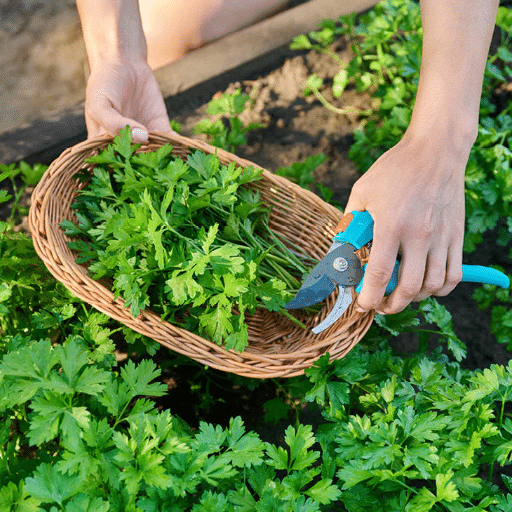Harvesting parsley is vital if we want to earn the tastiest plants from a flourishing herb garden. Whether you’re a home gardener or an expert in preparing gourmet food, knowing the proper way to harvest will sustain your gardening skills and the quality of parsley. This guide will cover everything, including how to know when it is time to how to harvest parsley for best effect, along with ways to harvest parsley that permit continuous growth. By the end of this article, you will feel reassured about putting together a plan to exploit parsley to keep them fertile and vigorous throughout the season.
Understanding Parsley

Optimal Harvesting Conditions: Parsley is harvested at its maximum when the plant is at least 6 inches tall with plenty of leaves, flowering into a lush, deep green color. It is best to harvest in the early morning hours with whichever dew is still on the leaves, just before the heat of the day threatens to wash away the essential oils of the leaves, which would affect the aroma and freshness of the herb.
Ideally, mature outer stems should be cut off while leaving inner stems intact so the plant continues to grow. Regular cutting of parsley keeps the plant healthy, providing fresh leaves all around the growing season.
Types of Parsley
| Type | Appearance | Flavor Profile | Best Use |
|---|---|---|---|
| Curly Leaf Parsley | Decorative with ruffled leaves | Mild flavor, sometimes grassy | Perfect for garnishing dishes |
| Flat-Leaf Parsley (Italian) | Flat, broad leaves | Stronger, more peppery flavor | Cooking and adding aromatic depth to dishes |
Each type serves different purposes in the kitchen, so it’s beneficial to have both varieties available to accommodate different kinds of recipes and tastes.
Growing Parsley in Your Herb Garden
Growing parsley in your herbal garden is rewarding and simple. From experience and research, parsley thrives under these conditions:
- Soil: Well-draining and fertile soil with consistent moisture
- Light: Full sun but appreciates some shade, particularly in warmer weather
- Starting: Begin with seeds (soak overnight to improve germination) or seedlings for faster results
- Maintenance: Frequent harvesting encourages foliage production
- Plant Type: Biennial plant that flowers and goes to seed the second year, but often grown as annual for fresh leaves
Benefits of Fresh Parsley

Culinary Benefits
- Intense flavor that elevates dishes from soups and salads to marinades and sauces
- Adds bright, herbaceous notes to recipes
- Pesticide-free when grown at home
Nutritional Benefits
- Vitamin A: Promotes immune health and youthful skin
- Vitamin C: Supports immune system function
- Vitamin K: Essential for good bone strength
- Antioxidants: Promote general well-being
When to Harvest Parsley
Timing Guidelines
- Plant Height: When stems reach about 6 inches (10 cm)
- Time from Planting: Usually after 70-90 days of planting
- Daily Timing: Early morning for best quality and moisture retention
- Frequency: Throughout the growing season for continuous fresh growth
Signs That Parsley is Ready to Be Picked
- Rich green color indicating a strong plant
- Firm stems showing maximum flavor potential
- Stems at least 10 centimeters tall
- Warning: Harvest before flowers appear, as bolting compromises flavor
Best Time of Year to Harvest Parsley
| Season | Activity | Notes |
|---|---|---|
| Spring | Plant after last frost | Parsley prefers cooler weather |
| Late Spring/Early Summer | Begin harvesting | Once stems are a few inches tall |
| Summer | Continuous harvesting | Encourages new growth |
| Early Fall | Continue harvesting | Can extend season with garden cloches |
| Mild Climates | Year-round growing | With adequate protection during cold spells |
Time of Day for Optimal Harvesting
Best Time: Early morning hours, just after the dew dries up and before warm weather builds up. This is when:
- Essential oils in leaves reach their peak
- Parsley has the most vivid flavor and aroma
- Stems and leaves remain crisp and fresh
- Ideal conditions for immediate use or storage
How to Harvest Parsley

Tools Needed for Harvesting Parsley
- Primary: Clean, sharp scissors or garden shears
- Alternative: Small gardening or pruning knife
- Collection: Basket or breathable container
- Sanitation: Warm soapy water or rubbing alcohol for tool cleaning
Step-by-Step Guide to Picking Parsley
1Harvest in the Morning
Stop harvesting parsley in the morning when the leaves are still fresh. This keeps them retained in flavor and nutrients, as they would lose these qualities under the hot mid-day sun.
2Pick Mature Leaves
Harvest older, mature stems coming from the outer portion of the plant. Choose the stems with the freshest green, and reject any that have yellowing and wilting leaves.
3Cutting Technique
Ensure that you use clean and sharp scissors or shears and clip each stem close to the base of the plant to encourage new growth. Never pull stems manually as it damages the plant and its roots.
4Proper Collection
Place the freshly cut stems in a basket or another breathable container. Keeping them in a shady place while you continue harvesting helps maintain their freshness.
5Clean Tools
After harvesting, it is good practice to clean your scissors or shears with warm soapy water or rubbing alcohol. This minimizes any chance of spreading disease during future use.
Harvesting Techniques for Best Yield
- Use sterile tools to prevent disease spread
- Cut outer stems first (more mature) while allowing inner stems to continue growing
- Place cut parsley in breathable containers
- Keep harvested parsley away from direct sunlight
- Clean and disinfect tools after each use
Storing and Freezing Parsley

Short-Term Storage (Up to 1 Week)
- Gently wash parsley with cold water to remove dirt or debris
- Pat dry with a clean towel or use salad spinner
- Wrap in a damp paper towel
- Place in a resealable plastic bag or an airtight container
- Store in refrigerator
Alternative Method – Bouquet Style
- Trim the ends of parsley stems
- Place the bunch in a tall glass of water like a flower bouquet
- Loosely cover leaves with a plastic bag
- Store in refrigerator
- Change water every couple of days
Methods to Freeze Parsley
| Method | Process | Best For |
|---|---|---|
| Ice Cube Method | Chop finely, place in ice cube tray, cover with water or olive oil, freeze | Soups, stews, sauces – easy portioning |
| Flat Freezing | Wash, dry, lay flat on baking sheet, freeze, then bag | When you need specific amounts |
| Direct Bagging | Chop and place directly in freezer bags, remove air | General cooking use |
References
-
Gardenary: Offers a detailed guide on harvesting parsley leaves to increase production. Read more here.1
-
Martha Stewart: Explains the best practices for harvesting parsley to maintain its fresh and full flavor. Check it out here.2
-
Click and Grow – Gardeners: Provides insights on cutting herbs, including parsley, and the right time to start harvesting. Learn more here.3
Frequently Asked Questions (FAQ)
How to harvest parsley from your garden?
To harvest parsley from your garden, you should focus on the outer stalks of the plant. Begin by using scissors or garden shears to snip the leaves from the stems, taking care to leave the center of the plant intact for continued growth. It’s important to harvest parsley regularly to encourage new stems, ensuring a bountiful supply of fresh parsley throughout the growing season. Aim to remove the lower leaves first, as they are typically the most mature and flavorful. Always harvest in the morning when the leaves are crisp and full of flavor, which is when they have the most essential oils.
When is the best time to pick parsley?
The best time to pick parsley is in the morning after the dew has dried, but before the sun is too hot. This ensures that the leaves are crisp and retain their flavorful oils. Harvesting parsley regularly can also promote new growth, allowing you to enjoy this herb longer. If you wait too long and the plant begins to flower, the leaves may become bitter. Look for lush, leafy growth, and remember that parsley is easy to grow, making it a fantastic addition to your herb garden.
How do I store parsley after harvesting?
To store parsley after harvesting, consider placing the stems in a glass of water like a bouquet, covering the leaves with a plastic bag to keep them from wilting. Alternatively, you can wrap the parsley in a damp paper towel and store it in a well-ventilated crisper drawer in your refrigerator. This method helps keep your parsley fresh for longer. If you want to store parsley for an extended period, consider chopping it and placing it in freezer bags for easy use later. This way, you can have flavorful parsley at your fingertips whenever you like!
Can I freeze parsley for later use?
Yes, you can freeze parsley for later use, which is a great way to preserve its flavor. Start by washing the parsley, removing the leaves from the stems, and then chopping it into small pieces. You can place the chopped parsley into freezer bags, ensuring to remove as much air as possible for better preservation. Some people also like to freeze parsley in ice cube trays with water or olive oil, making it easy to add to soups and sauces. Freezing parsley is an excellent option for those who want to keep their parsley fresh and flavorful without losing its quality.
How to regrow parsley from cuttings?
Regrowing parsley from cuttings is a simple and rewarding process. Start by taking healthy cuttings from the outside stalks of the plant, ensuring they are at least a few inches long. Place the cuttings in water, ensuring the leaves are above the waterline, and place them in a sunny spot. Over time, new roots will develop, and you can then transfer the cuttings to soil for continued growth. This method allows you to enjoy fresh parsley while maximizing your herb garden’s yield, showcasing how easy it is to grow and maintain this flavorful herb.









